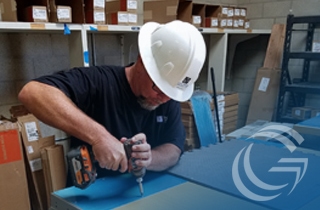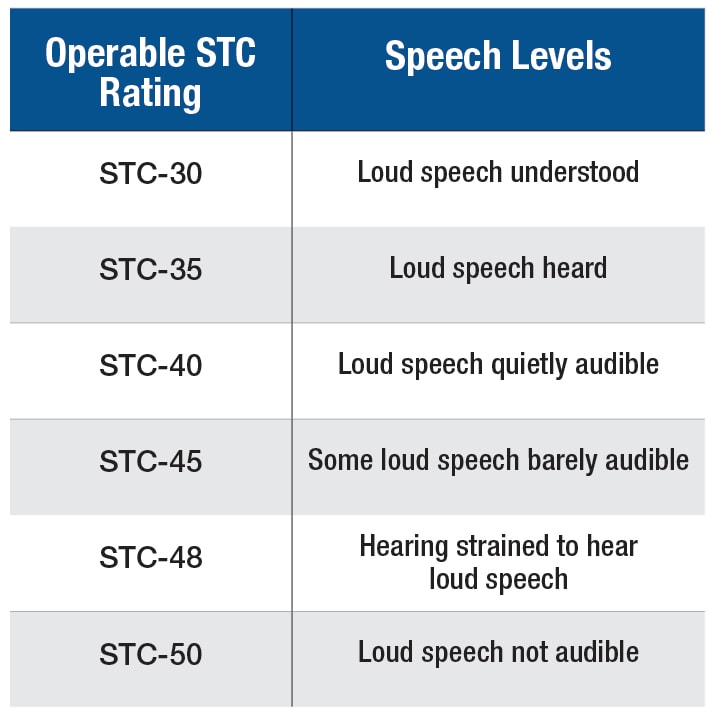
About STC Ratings
STC stands for (Sound Transmission Class). Acoustic products are given two STC ratings, one of which is a “sealed in place” rating, and the other is an “operable” rating. These ratings are determined for doors using two tests, both with and without acoustic putty sealing the door. The STC rating is the sound transmission loss that is achieved when using a soundproof door. This reduction is achieved through absorbing sound and sound insulation, preventing sound from entering a space with a barrier. The STC rating roughly indicates the decibel reduction that a door can provide.
How Acoustic Products Work
Understanding how sound is transmitted and how acoustic products work to reduce sound transmission allows you to make better decisions about these products. You can decide whether their use is appropriate for your facility, and learn how to choose the right STC door rating. Sound is measured in decibels, from an inaudible 0dB to around 40dB for a quiet office and sounds loud enough to cause physical pain, like a jet engine at about 130dB. Acoustic products use two main principles to reduce sound. Sound absorption, and sound insulation. Sound absorption is the use of materials to stop sound energy by soaking up the transmission of sound. Sound insulation is using barriers to prevent sound waves from entering a space or office environment.
Why Soundproof Your Facility Doors
Soundproofing the doors in your facility offers a number of advantages. It’s a useful direction for institutions in a range of industries, from professional offices to hospitals. Sound doesn’t have to be at a level that damages hearing to be disruptive to an environment. Even lower levels of sound can cause certain inconveniences. It can affect productivity in the workplace and could even impact patient well-being in medical settings. Additionally, privacy is also a significant concern. Ensuring that sensitive conversations aren’t audible to the unwanted hearing helps to protect your organization, particularly if you are subject to regulations such as HIPAA in the medical field.
Industries Benefiting From Soundproof Doors

Quieter environments in the hospitality world improve the guest experience. Guests in hotels and other accommodations don’t want to hear sound from neighboring rooms or from communal areas, such as bars, restaurants and lobbies.

Students need a quiet environment to enable them to concentrate on their studies. Whether learning from a teacher, studying independently or taking an exam, quiet spaces are necessary to reduce disruption and distraction.
In military and government organizations, noise reduction is necessary to maintain privacy. Sensitive information must be protected, and STC-rated doors can help facilitate that demand.
STC Ratings for Doors
A range of materials is used to create STC-rated doors with a level of mass that will inhibit the transmission of sound. STC ratings are based on a system of how much speech can be heard.
How STC Doors Are Tested
To test the STC of a door, the assembly is assessed using a sealed-in-place setup, using acoustic putty to seal around the edges of the door. Operable STC ratings are also tested, without acoustic putty but with gaskets, door bottoms and sills instead. Sound transmission loss is measured using a range of frequencies, with the average value used to determine the STC. Most doors fall within the STC 30 to 40 range, as it’s very difficult to achieve a rating at the higher end of the scale. The operable rating presents a more realistic figure for doors as they are actually used, rather than one based on a controlled scientific environment.
Getting the Most From STC Doors
STC doors do a lot of the work if you want to soundproof your facility. However, to get the most from them, it’s important to consider what else you can do after installation. Only a small opening can allow sound leakage, so you need to make sure you take steps to fill any gaps. Gasketing enables you to seal around a door, preventing any gaps around the jamb, head and sill. Doors need to be appropriately aligned so proper installation is essential.
Choose Quality

Acoustic protection isn’t only something that is beneficial to your facility. In some cases, it is also becoming part of building code. Some states and jurisdictions have implemented American National Standards Institute (ANSI) S12.60-2002, Acoustical Performance Criteria, Design Requirements, and Guidelines for Schools. These guidelines set out standards for acoustical performance in educational institutions and learning spaces. It requires a minimum STC-35 rating for classroom doors. There are also suggestions for how to accommodate deaf and hard of hearing people.
Performance Combinations
Acoustical door assemblies can also be manufactured for multiple performance requirements including fire ratings, blast resistance, bullet resistance, radio frequency, shielding, or other possible combinations.Doors can also incorporate vision light windows, paired swings, and horizontal sliding.
Turn to G&G Door Products, Your Acoustical Experts for Professional Help
To get the most from STC-rated doors, you not only need to choose the correct products but also ensure expert installation. Acoustical experts can provide assistance with selecting the right products and carrying out proper installation. You may also need help with adjusting STC doors after installation, as they can become less effective over time due to natural shifting of the building and other factors. However, proper installation can help to prevent this so that your doors remain acoustically effective. You need experts who have the correct knowledge and training to meet your facility’s needs, and carry out all work safely with high standards. At G&G Door Products, you can be sure that you will receive the expertise and accurate installation that you need to complete your project, and improve your building facility for everyone who uses it.


